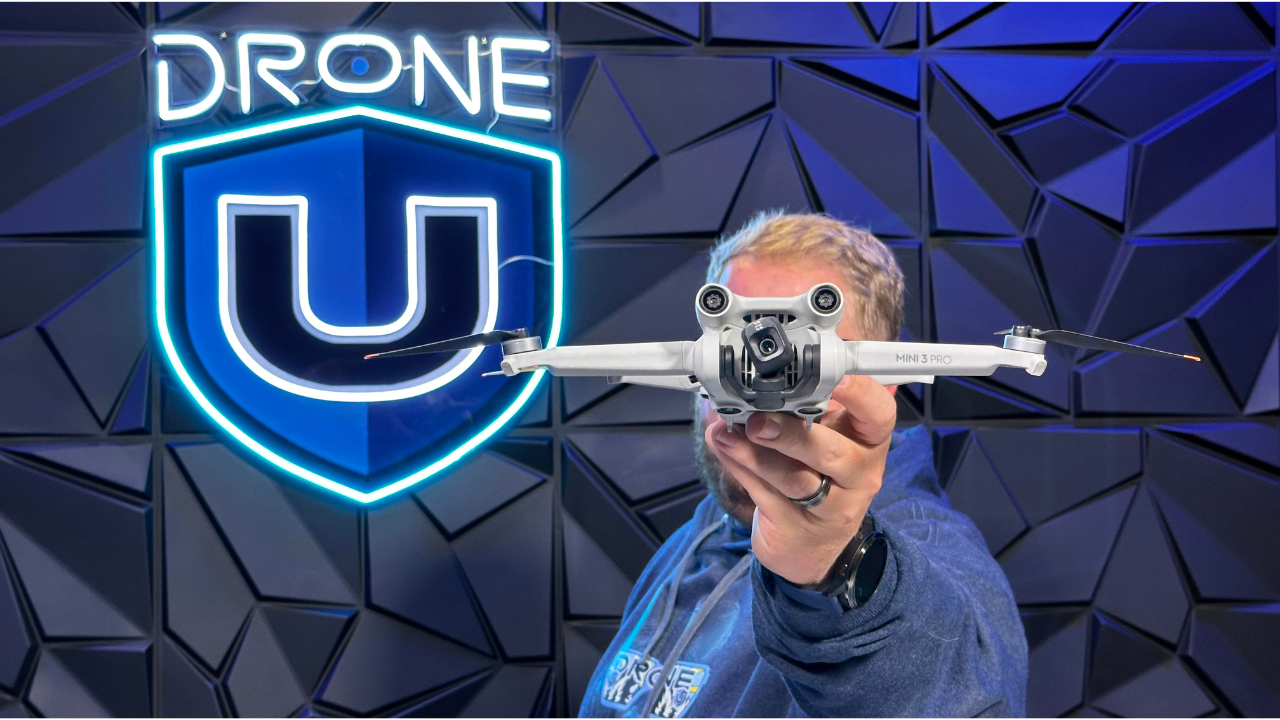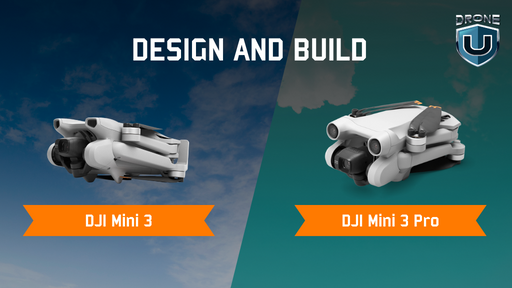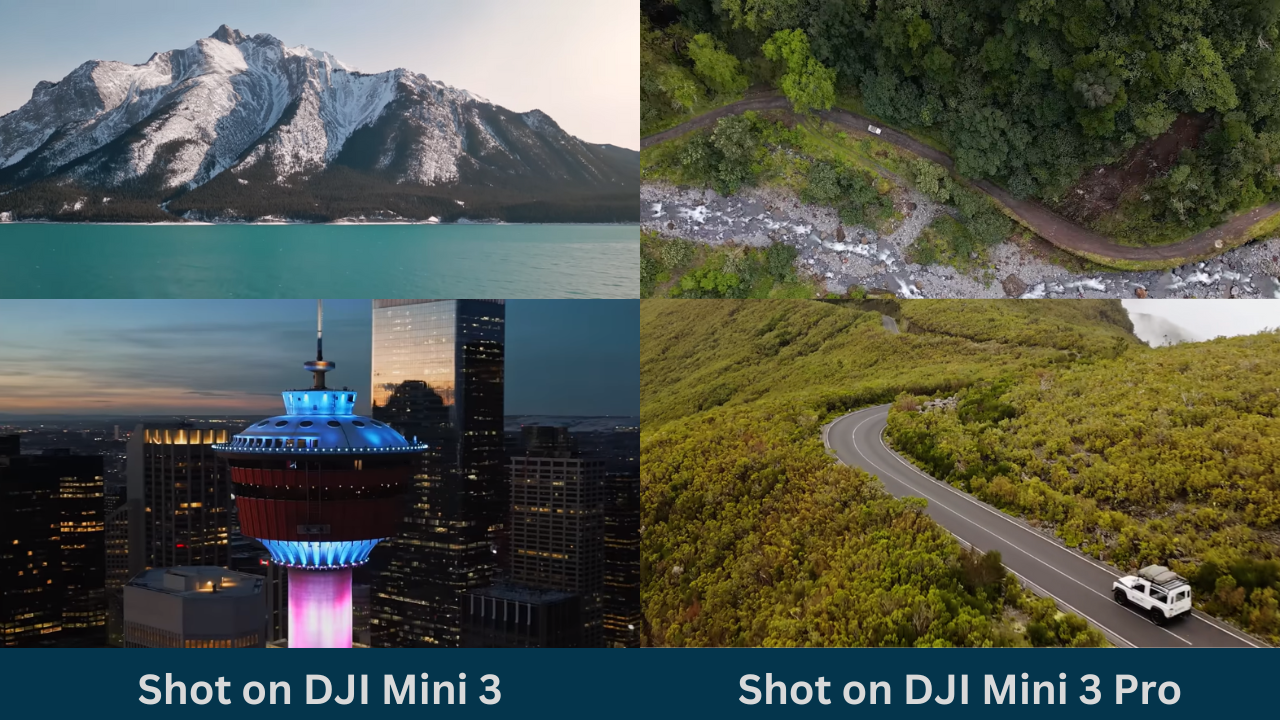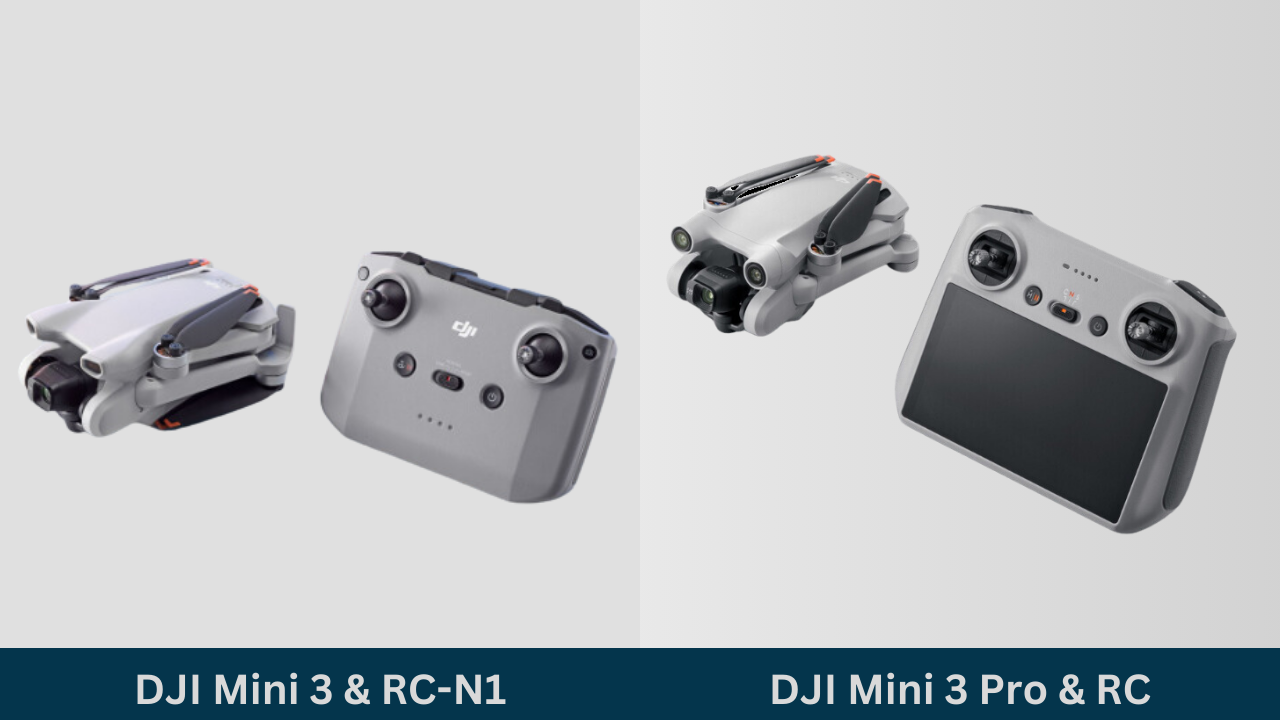
The drone industry is experiencing a stratospheric rise. And it isn’t limited to capturing breathtaking aerial photos or videos. Drones are revolutionizing entire industries – ranging from agricultural and surveying to public safety and grocery delivery.
From longer flight times to crystal-clear cameras and autonomous flight, drone technology has also seen a remarkable evolution. Talking about innovation in drone tech, the DJI Mini 3 has recently garnered a lot of attention from the drone world.
The two variants, DJI Mini 3 and Min 3 Pro stand out in terms of versatility, flight time, and ease of use.
Hence, the Drone U team decided to take a closer look at these two models to see how they stack up against each other.
In this article, we dive into comparing these two highly capable drones – DJI Mini 3 vs. Mini 3 Pro. Hopefully, it will help you choose a bird that’s more suitable to your specific needs and use cases.
First, let’s take a look at the performance criteria we took into consideration when comparing these birds.
The Criteria We Choose to Compare DJI Mini 3 vs. Mini 3 Pro

Here are the criteria we took into consideration when comparing these two models:
- Purpose: Understanding the intended use of the drone’s capabilities ensures you’re on the path to success.
- Skill Level and Experience: Consider your pilot’s license. Novices may lean towards user-friendly models with intuitive controls and helpful flight modes, while trained drone pilots look for advanced features.
- Portability: Consider the drone’s size and weight, especially if you’re a frequent traveler or regularly change your flight locations.
- Camera and Imaging Requirements: Professional drone photographers pursuing high-resolution masterpieces may prefer powerful lenses and intricate settings, while casual drone enthusiasts might find simpler setups entirely satisfactory.
- Battery Life and Flight Time: It’s essential to grasp the drone’s battery life and flight time to plan your aerial adventures effectively.
- Legal and Regulatory Compliance: Familiarize yourself with local regulations, weight limits, registration requirements, and no-fly zones to avoid unwanted turbulence.
DJI Mini 3 vs. Mini 3 Pro Comparison
This section compares the design and build, flight performance, remote controller, battery, pricing, and packaging of both drones.
Let’s start with the design and build.
1. DJI Mini 3 vs. Mini 3 Pro – Design and Build

| Specification | DJI Mini 3 | DJI Mini 3 Pro |
| Dimensions (L x W x H) | Folded: 148 x 90 x 62 mm;
Unfolded (with propellers): 251 x 362 x 72 mm |
Folded: 145 x 90 x 62 mm;
Unfolded (with propellers): 251 x 362 x 70 mm |
| Weight | 248g | Less than 249g |
The DJI Mini 3 and Mini 3 Pro, much like their predecessors, are renowned for their compact and lightweight designs.
While both models share the signature compact and lightweight design of the Mini series, there are subtle differences in dimensions and weight. It’s crucial to consider these factors based on individual preferences and specific use cases.
The Mini 3 places a premium on minimalist weight and portability. Its sleek design and lighter materials make it exceptionally travel-friendly and easy to deploy, making it an ideal choice for casual flight enthusiasts and photographers searching for a highly portable aerial platform.
Conversely, the Mini 3 Pro boasts a sturdier and more refined construction. Enhanced materials contribute to increased durability and improved wind resistance, making it suitable for more challenging flight conditions and professional applications. However, this comes at the cost of a slightly heavier frame than the Mini 3.
2. DJI Mini 3 vs. Mini 3 Pro – Camera Capabilities
 Credit: DJI
Credit: DJI
| Specification | DJI Mini 3 | DJI Mini 3 Pro |
| Sensor | 1/1.3-inch CMOS
Effective Pixels: 12 MP |
1/1.3-inch CMOS
Effective Pixels: 48 MP |
| Shutter Speed | Electronic Shutter: 2-1/8000 s | Electronic Shutter: 2-1/8000 s |
| ISO Range | Video: 100-3200
Photo: 100-3200 |
Video: 100-6400 (Auto), 100-6400 (Manual)
Photo: 100-6400 (Auto), 100-6400 (Manual) |
| Max Image Size | 4000 x 3000 | 4:3: 8064 x 6048 (48 MP), 4032 x 3024 (12 MP)
16:9: 4032 x 2268 (12 MP) |
| Photo Format | JPEG/DNG (RAW | JPEG/DNG (RAW |
| Video Format | MP4 (H.264) | MP4/MOV (H.264/H.265) |
| Max Video Bitrate | 100 Mbps | 150 Mbps |
| Image Quality | 4K/30fps HDR | 4K/30fps HDR
4K/60fps |
| Live View Quality | 720p/30fps | 1080p/30fps |
| Still Photography Modes | Single Shot: 12 MP
Timed: 12 MP Panorama: Sphere, 180°, Wide Angle |
Single Shot: 12 MP
Burst Shooting: 12 MP, 3/5/7 frames Timed: 12 MP Panorama: Sphere, 180°, Wide Angle, Vertical |
Resolution and image quality are paramount for drone pilots who prioritize capturing stunning visuals and crisp details in their aerial shots.
Considering these factors might help you in making the right decision.
| Features | Mini 3 | Mini 3 Pro |
| Sensor Resolution | 1/2.3-inch CMOS sensor with 12 megapixels. It is a respectable resolution for everyday use, but you might need help with detail in complex scenes or zooming. | 1/1.3-inch CMOS sensor with 48 megapixels. This significantly larger sensor and higher resolution capture superior detail, allowing for zooming and cropping without significant sharpness loss. |
| Video Recording | 4K and 1080p recording at 25/30/50 fps with a bitrate of 100 Mbps. Suitable for general videography but lacks options for high-bitrate or slow-motion capture. | Shoots stunning 4K at 60 fps and 1080p at 240 fps with a bitrate of 150 Mbps. It opens up options for smooth slow-motion and cinematic capture. |
| Low-light Performance | Maximum ISO of 6400. While decent for basic low-light situations, you might encounter noise and softness in heavily shaded areas or nighttime shots. | It has a much higher maximum ISO of 12800. It significantly improves low-light performance, allowing cleaner capture in challenging lighting conditions. |
Additional Features
- Mini 3: Lacks advanced shooting modes like QuickShots or MasterShots.
- Mini 3 Pro: Offers an array of intelligent shooting modes for creative and automated capture, including QuickShots, MasterShots, and FocusTrack.
3. DJI Mini 3 vs. Mini 3 Pro – Flight Performance

Flight range is crucial for drone pilots who wish to explore larger areas or capture footage from a distance.
While both the DJI Mini 3 and Mini 3 Pro promise extended aerial adventures, their flight performance takes slightly different routes:
| Specification | DJI Mini 3 | DJI Mini 3 Pro |
| Max Flight Time | 38 mins | 34 mins |
| Operating Temperature | -10°C to 40°C (14° to 104° F) | -10°C to 40°C (14° to 104° F) |
| Max Hovering Time | 33 mins | 30 mins |
| Max Speed (at sea level, no wind) | 16 m/s | 16 m/s (S Mode)
10 m/s (N Mode) 6 m/s (C Mode) |
| Max Wind Speed Resistance | 10.7 m/s (Level 5) | 10.7 m/s (Level 5) |
| Sensing System | Downward | Forward, Backward, &
Downward |
| Video Transmission (CE) | DJI O2 | DJI O3 |
| Latency | Approx. 200 ms | Approx. 120 ms |
These factors might help you in making an informed decision:
| Features |
Mini 3 |
Mini 3 Pro |
| Maximum Flight Time | Up to 38 minutes with the standard Intelligent Flight Battery. It is already quite impressive for a drone in its weight class and allows for capturing a good amount of footage on a single charge. | Slightly shorter flight time of 34 minutes with the standard Intelligent Flight Battery. However, the Mini 3 Pro has an advantage with the optional Intelligent Flight Battery Plus, which boosts its airtime to a whopping 47 minutes! |
| Speed and Maneuverability | It is slightly faster, with a maximum speed of 58 km/h, compared to the Mini 3 Pro’s 57 km/h. | It is more agile and responsive due to its upgraded propeller design and slightly higher weight. |
| Transmission Range | Utilizes the DJI O2 transmission system, offering a decent range of up to 6 km (4.3 mi) in ideal conditions. | Equipped with the upgraded DJI O3 transmission, it boasts a significantly extended range of up to 15 km (9.3 mi) for a more robust connection and worry-free flight experience. |
Wind Resistance
Both drones, The Mini 3 and Mini 3 Pro, boast a Level 5 wind resistance rating, meaning they can handle moderate wind speeds of up to 29-38 km/h. It makes them suitable for flying in most outdoor conditions.
The DJI Mini 3 takes the lead over the Mini 3 Pro regarding the base flight time, but the Mini 3 Pro offers an extended optional flight time and a longer transmission range. If you prioritize longer flights right out of the box, the Mini 3 might be better for you.
4. DJI RC vs. RC-N1: Remote Controller

| Specification | DJI RC | RC-N1 |
| Built-in Screen | Yes | No |
| Screen Size | 5.5 inches | Supports devices up to 180mm (L) x 86mm (W) x 10mm (H).
& Compatible with tablet holder. |
| Weight | 390 g | 387 g |
| Battery Life | 4 hours | 6 hours |
| Antennas | 2 | 2 |
DJI is renowned for crafting intuitive and user-friendly controllers, and the controllers for the DJI Mini 3 and Mini 3 Pro are expected to uphold this reputation.
The range and connectivity features of the remote controller dictate how far and under what conditions the user can maintain control of the drone. Choosing a suitable remote controller can significantly impact your drone flying experience.
Both the DJI Mini 3 and Mini 3 Pro have two options: the dedicated DJI RC and the smartphone-based RC-N1.
Let’s delve into their key differences to help you choose the perfect pilot’s companion:
Built-in Screen vs. Mount
- DJI RC: This dedicated controller boasts a built-in 5.5-inch 1080p display, eliminating the need for a smartphone. It offers superior brightness and clarity, especially in direct sunlight, and provides a seamless, distraction-free flying experience.
- RC-N1: This budget-friendly option requires mounting your smartphone onto the remote. While offering some flexibility in screen size, it can be cumbersome and susceptible to glare in bright conditions. Additionally, battery drain on your phone can become an issue during longer flights.
Controls and Ergonomics
- DJI RC: Features dedicated physical buttons and joysticks, providing precise control and tactile feedback for a more immersive flying experience. It’s also lighter and more comfortable to hold for extended periods.
- RC-N1: Relies on touchscreen controls on your smartphone, which can be less responsive and require more attention. The added weight of the phone can also make it less ergonomic for longer flights.
Battery Life
- DJI RC: A long-lasting internal battery offers up to 4 hours of flight time on a single charge. It eliminates the need for additional batteries or cables for your phone.
- RC-N1: Drains your smartphone’s battery, so you must carry power banks or consider the battery life limitations when planning longer flights.
5. DJI Mini 3 vs. Mini 3 Pro – Battery and Charging
Charging time is crucial for drone pilots who want to minimize downtime between flights. And when it comes to the Mini 3 and Mini 3 Pro, there are subtle differences in battery charging that deserve a closer look:
| Specification | DJI Mini 3 | DJI Mini 3 Pro |
| Capacity | Intelligent Flight Battery: 2453 mAh | Intelligent Flight Battery: 2453 mAh |
| Weight | Intelligent Flight Battery: Approx. 80.5 g | Intelligent Flight Battery: Approx. 80.5 g |
| Nominal Voltage | 7.38 V | 7.38 V |
| Type | Li-ion | Li-ion |
| Charging Temperature | 5° to 40° C (41° to 104° F) | 5° to 40° C (41° to 104° F) |
| Charging Time | Approx. 64 minutes (with the DJI 30W USB-C Charger) | Approx. 64 minutes (with the DJI 30W USB-C Charger) |
Standard Battery Charging
DJI Mini 3: Charges its standard Intelligent Flight Battery in just 38 minutes using a 30W charger. It translates to a quick turnaround time between flights, allowing you to capture more footage or explore further without lengthy idle periods.
DJI Mini 3 Pro: It takes slightly longer, at 47 minutes, to charge its standard Intelligent Flight Battery with a 30W charger. While not a significant difference, it’s worth noting if maximizing efficiency is your top priority.
Intelligent Flight Battery Plus Charging
Both drones offer optional Intelligent Flight Battery Plus upgrades for extended flight times, but their charging times differ:
- Mini 3: It takes 52 minutes to charge the Plus battery with a 30W charger—this slightly longer charging time balances well with the extended flight time of the larger battery.
- Mini 3 Pro: It takes 65 minutes to charge the Plus battery with a 30W charger. The longer charging time reflects the significantly higher capacity of the Pro’s Plus battery.
Fast Charging Options
Watch this video to learn – how pilots can check their drone batteries to ensure a safe flight
- Mini 3: Supports fast charging with a 65W charger, reducing its standard battery charging time to just 25 minutes. It is a significant bonus for pilots who prioritize minimal downtime and rapid battery replenishment.
- Mini 3 Pro: Unfortunately, it lacks a dedicated fast-charging option and remains limited to 47 minutes with a 30W charger for its standard battery. However, some users report achieving slightly faster charging with higher-wattage chargers (although not officially supported by DJI).
6. DJI Mini 3 vs. Mini 3 Pro – Pricing and Packages

| Package | Cost (Dynamic) |
| DJI Mini 3 Pro with DJI RC-N1 | USD 759 |
| DJI Mini 3 Pro with DJI RC | USD 909 |
| DJI Mini 3 Pro without Remote Controller | USD 669 |
| DJI Mini 3 with DJI RC-N1 | USD 469 |
| DJI Mini 3 with DJI RC | USD 609 |
| DJI Mini 3 without Remote Controller | USD 379 |
Along with price, there are some key points to consider:
Pricing Disparities
The price difference between the Mini 3 and Mini 3 Pro stems from several significant differences. The Pro model features a substantially upgraded camera, including a larger sensor, higher resolution, and enhanced low-light performance. Moreover, it excels in flight performance, offering a more extended range and advanced obstacle avoidance capabilities.
Lastly, the Pro has professional-grade features like the Cinelike D-Log profile, vertical shooting mode, and intelligent flight modes like QuickShots and MasterShots. Assess if these advanced functionalities justify the higher price tag based on your needs.
Professional-grade Features
The Mini 3 Pro is tailored for professionals and dedicated enthusiasts, offering a comprehensive array of cutting-edge features. Its improved camera specifications, prolonged flight time, and extra intelligent flight modes open creative possibilities and yield cinematic-quality footage.
While these advanced capabilities come with a higher price tag, the investment can be well justified for content creators in search of a robust aerial platform.
Accessories and Upgrades
To enhance your drone experience further, consider exploring optional accessories like ND filters for precise light control, spare batteries for extended flight times, or propeller guards for added protection. Remember, these add-ons come at an additional cost, so factor them into your purchasing budget.
Warranty and Care Plans
DJI offers various warranty and care plans extending coverage and protection for your drone. These plans provide peace of mind, especially for professional users or those worried about potential accidents or damage. Consider investing in one of these plans if you want extra security and support for your valuable aerial investment.
After reviewing the features comparison, let’s examine the pros and cons of mini 3 and mini 3 Pro.
Pros and Cons of DJI Mini 3 vs. Mini 3 Pro
Considering the pros and cons of the DJI Mini 3 and Mini 3 Pro is essential for potential buyers to make an informed decision based on their specific needs and preferences.
Here’s a breakdown of the positives and negatives:
| Feature | DJI Mini 3 | DJI Mini 3 Pro |
| Price | Affordable | More expensive |
| Weight | Ultra-lightweight (249g) | Slightly heavier (249g) |
| Flight Time | Up to 38 minutes | Up to 34 minutes |
| Camera | 12MP sensor, 2.7K video | 48MP sensor, 4K 60fps video |
| Basic, beginner-friendly | Advanced, including obstacle avoidance, Cinelike D-Log, vertical shooting | |
| Range | Up to 2 km | Up to 6 km |
| Wind Resistance | Moderate | Improved |
| Ideal for | Budget-conscious beginners, casual users | Professional and serious hobbyists, those needing advanced features |
| Pros | Super lightweight and portable, affordable, good flight time, easy to fly | Superior camera quality, advanced features, longer range, improved wind resistance |
| Cons | Lower camera quality, limited features, shorter range | Higher price tag, slightly heavier, shorter battery life |
Now that you’ve explored the features and weighed the pros and cons, here are our recommendations for purchasing the drone based on specific user needs.
Recommendations Based on Specific User Needs
Choosing between the Mini 3 and Mini 3 Pro ultimately depends on individual user needs and priorities. Recommendations can be tailored to different user profiles:
For Recreational drone pilots: The DJI Mini 3 may be more suitable, providing a balance of portability, camera capabilities, and flight performance at a more accessible price point.
For Enthusiasts and Professionals: The Mini 3 Pro, with its enhanced camera features, extended flight capabilities, and potentially advanced functionalities, is recommended for drone pilots seeking professional-grade performance.
Budget Considerations: Drone pilots with budget constraints may find the Mini 3 appealing, as it is expected to deliver solid performance without the premium price tag associated with the Pro model.
Versatility Seekers: drone pilots who desire a versatile drone for recreational and semi-professional use may find value in the Pro variant, as it offers a broader range of features.
Closing Thoughts on the DJI Mini 3 vs. Mini 3 Pro
The comparison between the DJI Mini 3 and Mini 3 Pro showcases the evolution of the Mini series, providing drone pilots with options that cater to different needs and preferences. The Mini 3 continues the tradition of a compact and user-friendly drone, while the Mini 3 Pro elevates the experience with enhanced camera capabilities and extended flight performance.
Before you lift off take a moment to check your priorities:
- Consider your budget
- Consider intended use and the features you can’t live without.
To break it down even further:
If you’re craving an easy-to-fly budget buddy, go for the Mini 3.
If you’re longing for pro-level features and extended airtime, go for Mini 3 Pro.







Add Your Comment